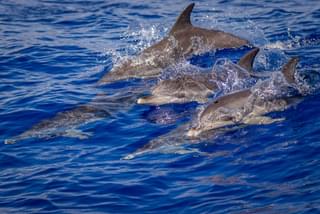Sei whale

Balaenoptera borealis
12 - 16m
Grey
Baleen
Dorsal fin
Sei whales are dark grey with a long thin body. They have a narrow head with a single median ridge on the slightly arched rostrum and pale grey chevrons behind the blowhole. Their colouration and shape make them easy to confuse with fin whales, but there are a few notable differences. Sei whales are shorter than fin whales and also have a shorter blow. When the whale surfaces their blow hole can be seen at the same time as their dorsal fin. The dorsal fin of a sei whale is more upright than that of a fin whale.
Key features:
- ~3m tall, straight blow
- Upright, sickle shaped dorsal fin
- Left and right lower jaw is dark grey
- Blow and dorsal fin visible at the same time when surfacing
Behaviour
Sei whales tend to travel alone or in pairs. They are one of the fastest rorqual whales and can reach speeds of 60km/h over short distances, skim feeding and very occasionally breaching. When they dive, they don’t raise their tail flukes but tend to just sink into the water.
Threats
Although not a traditional whaling target, sei whales were heavily exploited through the 1960’s and 70’s until they were made a protected species in 1976 and the international whaling ban came into force in 1986. Currently they are vulnerable to human impact through chemical and noise pollution, ship strikes and entanglement in fishing gear.
Distribution
Sei whales have a cosmopolitan distribution but appear to favour temperate to sub-polar waters. Typically they are restricted to deep pelagic waters and are rarely found near the coasts. They feed in cool temperate waters in the summer and are believed to migrate into warmer lower latitudes in the subtropics for winter.

Study whales and dolphins as an ORCA OceanWatcher
The ORCA OceanWatchers online training course, along with a bespoke app, will enable everyone to collect data about whales, dolphins and porpoises. And it can be collected from anywhere that you can see the sea - whether that’s from your local beach, on holiday at the coast, scanning the seas from a cruise ship, travelling via ferry, or from your own boat.
You may also be interested in






